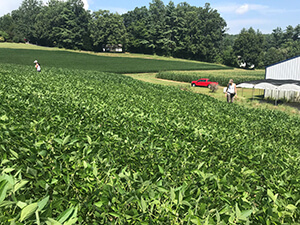
If you live east of the Rockies, chances are you live within a few miles of a soybean field. After corn, which covers 92.7 million acres in the United States, soybean fields cover the most land of any agricultural crop — 87.6 million acres. Soybean fields are a ubiquitous part of the landscapes that many of us see every day.
Conventional wisdom suggests that soybeans don’t need bees. In other words, soybeans are generally considered a “pollinator-independent crop” that doesn’t benefit when its flowers are visited by insect pollinators. Because of this, no soybean producer that I’m aware of rents honey bees or manages their land to promote populations of wild pollinators in an effort to maximize pollination.
But are soybean farmers ignoring pollinators to their own detriment? Do bees visit soybean flowers and does yield increase when flowers are pollinated? Does pollination increase if pollinator-friendly habitat that promotes bees is located adjacent to soybean fields? These are the topics for the fifty-third Notes from the Lab, where I summarize “Evaluating the impact of increased pollinator habitat on bee visitation and yield metrics in soybean crops,” written by Hannah Levenson and colleagues and published in the journal Agriculture, Ecosystems and Environment [2022].
In a previous Notes from the Lab [160(2):199-201], we learned that honey bee colonies in soybean-dominated landscapes are healthier and produce more honey when native prairie is located adjacent to soybean fields (Dolezal et al. 2019). The message from this study is clear: If we care about conserving bees and promoting pollinator health, we should make sure there’s natural habitat next to soybean fields, especially in the Midwest and other areas where corn and soybean fields dominate the landscape.
But what about the complementary question? Do soybeans (and by extension, soybean farmers) also benefit when natural habitat is adjacent to soybean fields? To address this question, Levenson and colleagues took advantage of a 2015 initiative titled “Protecting NC Pollinators,” implemented by the North Carolina Department of Agriculture and Consumer Services (NCDA&CS), which mandates planting and continuous maintenance of pollinator habitat at all 18 NCDA&CS and NC State University Research Stations across the state.
The authors sampled pollinators, observed pollination behaviors, and assessed soybean yield at 8 of the 18 sites across North Carolina (Figure 1). Pollinators were collected and observed 2-3 times during soybean bloom at three locations at each of the sites: wildflower habitat (see Photo 1), soybean fields adjacent to the wildflower habitat (see Photo 2), or soybean fields that didn’t have adjacent wildflower habitat (negative control). An example of how the sampling locations were organized at each site is shown in the magnified portion of Figure 1.
All bees collected at each site were taken back to the lab and identified to the lowest taxonomic level possible using published keys and expertise of the authors. Pollen was collected from the bodies of the three most abundant bee species — the Western honey bee (Apis mellifera), common Eastern bumble bee (Bombus impatiens), and Eastern carpenter bee (Xylocopa virginica) — and identified via microscopy to assess whether bees that were visiting soybean flowers collected pollen from the crop. Finally, several metrics of yield were compared between soybean fields with and without adjacent wildflower habitat. The number of seeds per pod, total number of seeds per plant, average seed weight per plant, and the number of deformed seeds per plant were determined for 30 plants in each soybean field.
So, what did they find? Do bees visit soybean flowers? Yes. As seen in Figure 2, a diverse bee community was found visiting soybean flowers regardless of whether the field was adjacent to wildflower habitat or not. The most abundant groups of bees visiting soybean flowers were honey bees and bumble bees, but several other groups were also observed, including sweat bees, parasitic bees, and carpenter bees (see Photo 3).
All bees that were sampled in soybean fields had soybean pollen on their bodies (see Photo 4), meaning they could potentially be moving pollen and therefore helping to pollinate soybean flowers.
Does having pollinator-friendly habitat next to soybean fields promote more pollinators? Sort of. Overall, different species of bees visited the wildflowers compared to soybean fields. Compared to the negative control fields, fields with adjacent wildflowers tended to host bee communities more similar to the wildflower habitat bee communities — though it was not a statistical
difference.
What about pollination? Does soybean yield increase when pollinator-friendly habitat is located next to fields? Yes. And this is where Levenson and colleagues’ study really breaks ground. Total seeds (beans) per plant didn’t differ between ….


